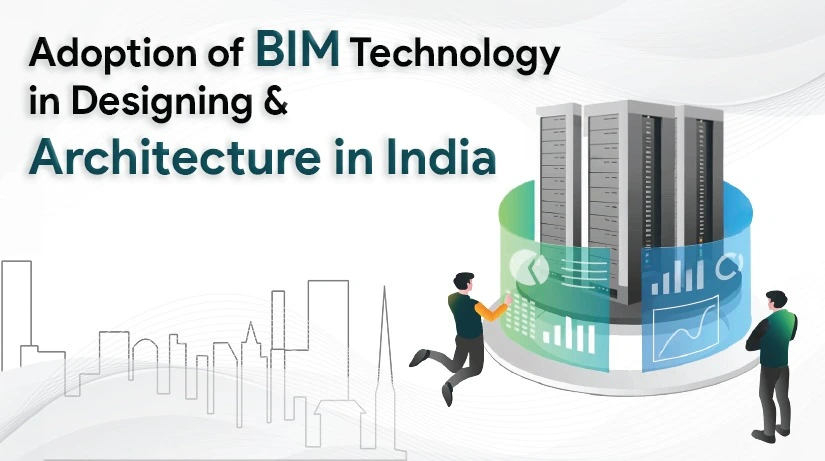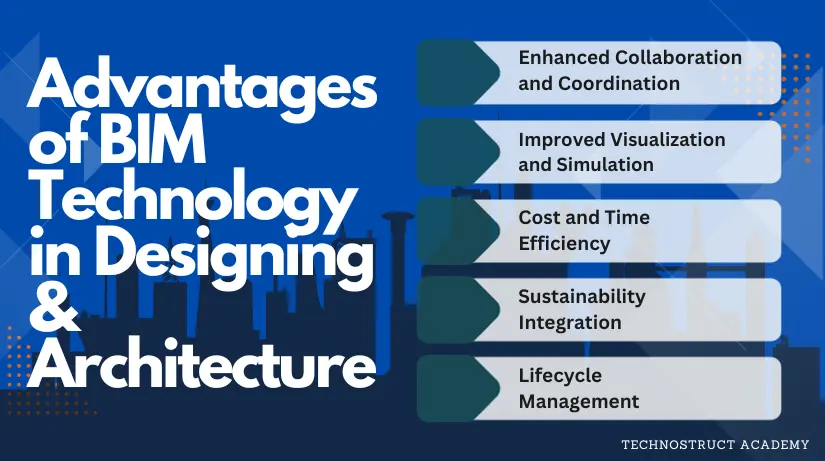Adoption of BIM Technology in Designing & Architecture in India
Mar 27, 2023
Category: Industry Trends
Admin

In the dynamic realm of architecture and design, technological advancements continually reshape the landscape. One such transformative force making waves in India is Building Information Modeling (BIM) technology. This innovative approach has become a cornerstone in the evolution of design and architecture, revolutionizing the way professionals conceptualize, plan, and execute projects.
The variety of BIM services outsourced to Indian companies such as 3D BIM Services, Computer-aided Design, Scan to BIM Services, Drawing Production, 4D Construction Sequencing, and 5D Cost Integration, among other processes, has led to the immediate and more fierce adoption of Building Information Modeling (BIM) processes for faster and efficient execution of projects.
The Rise of BIM Technology
What is BIM?
BIM technology, an acronym for Building Information Modeling, is a holistic process that involves creating and managing digital representations of the physical and functional characteristics of a structure. This method integrates various aspects of a project, from the initial design phase to construction and maintenance, collaboratively and efficiently.
BIM provides an opportunity for each party to offer input, enhancing precision throughout the building phase, designers to witness the realization of their vision. Modifying the model reflects instantaneously in a virtual setting, boosting efficiency, and minimizing the need for time-consuming and expensive revisions.
BIM in Indian Context
India’s architectural landscape has witnessed a paradigm shift with the widespread adoption of BIM technology. Architects, engineers, and construction professionals are embracing this approach to enhance project coordination, reduce errors, and optimize resource utilization. The integration of BIM in the Indian design and architecture sector marks a significant leap toward modernization.
BIM entered the Indian Construction Industry in the latter part of the first decade of the 21st century. The initial attraction towards BIM in India stemmed from a requirement for an interactive tool that closely replicates the intricacies of a project, consolidates all information in a central location, and establishes cross-links among the data.
Watch Now: The Evolving Space of Indian Construction Management
Advantages of BIM Technology in Designing & Architecture
BIM enhances transparency and efficiency in the design and construction stages, providing increased control during operations. These advantages collectively contribute to a more sustainable construction process and product.

Enhanced Collaboration and Coordination
BIM fosters seamless collaboration among various stakeholders involved in a project. Designers, architects, engineers, and contractors can work concurrently on a shared platform, streamlining communication and minimizing discrepancies. Collaboration stands out as a key advantage of Building Information Modeling (BIM) as both a process and a platform.
A robust BIM solution facilitates the seamless exchange of precise and pertinent information among diverse parties involved in a project, including designers, managers, and stakeholders. BIM coordination guarantees a unified informational foundation for all involved, mitigating the risk of errors and the need for rework, ultimately saving time and resources.
Improved Visualization and Simulation
BIM enables realistic 3D visualizations and simulations, offering stakeholders a virtual walkthrough of the proposed structure. This enhances decision-making processes and allows for better communication of design intent. BIM visualization empowers designers and clients to comprehensively view their projects.
It also facilitates progress tracking and prompt identification of any setbacks. SimScale serves as a simulation platform, collaborating with BIM software models to facilitate testing, validation, and optimization of various project designs, spanning from educational facilities and parking structures to tunnels, railways, roads, bridges, and more.
Cost and Time Efficiency
By providing a comprehensive digital representation of a project, BIM helps in identifying potential issues before construction commences and saves cost and time. This preemptive approach reduces the likelihood of costly errors and alterations during the construction phase, ultimately saving both time and resources.
BIM contributes to enhanced communication and collaboration among various project stakeholders, leading to cost-effective outcomes. It offers a comprehensive three-dimensional representation of the construction project, facilitating seamless sharing among team members, including project planning, fostering real-time collaboration, and enhancing resource allocation.
Sustainability Integration
BIM allows architects and designers to incorporate sustainable practices seamlessly. The technology facilitates the analysis of environmental impacts, energy consumption, and other crucial factors, empowering professionals to create environmentally conscious designs.
Integrating multicriteria decision-making (MCDM) methodologies with building information modeling (BIM) enhances decision-making reliability in the evaluation of construction project sustainability. BIM is also used to select construction materials with a lower environmental impact.
Lifecycle Management
Beyond the construction phase, BIM continues to be valuable during the maintenance and operation of a structure. The digital model serves as a repository of information, aiding in efficient facility BIM management and future renovations.
Lifecycle BIM involves the generation, upkeep, and application of building information to oversee the ongoing operations and maintenance of structures throughout their entire operational lifespan, showcasing the effects of BIM for the construction project lifecycle over the BIM stages.
Challenges and Opportunities in Implementing BIM in India
Infrastructural Challenges- Despite its transformative potential, the widespread adoption of BIM in India faces challenges related to infrastructure and technology accessibility. The need for robust IT infrastructure and high-speed internet can be a hindrance in certain regions.
Skill Gap– A comprehensive implementation of BIM requires skilled professionals who are proficient in using the technology. Bridging the skill gap through training programs and educational initiatives is crucial for the successful integration of BIM in the Indian design and architecture sector.
Cost Implications- While BIM can lead to long-term cost savings, the initial investment in technology and training can be perceived as a barrier, particularly for smaller firms. However, recognizing the long-term benefits can outweigh the initial costs.
Regulatory Framework- The implementation of BIM in India is also contingent on the development of a supportive regulatory framework. Clear guidelines and standards need to be established to ensure uniformity and consistency in BIM adoption across the industry.
Case Studies: BIM Success Stories in Indian Architecture
Delhi Metro Rail Corporation Case
Several iconic structures in India have leveraged BIM technology for their successful realization. The Delhi Metro Rail Corporation’s extensive use of BIM in the construction of metro stations stands as a testament to the efficiency and precision achievable through this technology.
Suzlon One Earth campus(Pune) Case
The Suzlon One Earth campus in Pune exemplifies the integration of BIM for sustainable design. The technology allowed architects to optimize the use of natural light, ventilation, and energy, resulting in a LEED Platinum-rated green building.
Future Prospects of BIM in Indian Designing & Architecture
Technological Advancements– As technology continues to advance, the capabilities of BIM are expected to evolve further. The integration of artificial intelligence and machine learning into BIM systems holds the promise of enhanced predictive modeling and analysis.
Standardization and Certification – The development of industry-wide standards and certifications for BIM usage is on the horizon. This will not only ensure the quality of BIM processes but also provide a benchmark for professionals and organizations.
Increased Collaboration and Integration- BIM’s success lies in its collaborative nature. Future developments may see even greater integration, allowing seamless communication between various stakeholders, including clients, architects, engineers, and contractors.
Also Read: BIM in Civil Engineering: Roads, Bridges, and More
Conclusion: Transforming Indian Architecture Through BIM
In conclusion, the adoption of BIM technology in designing and architecture marks a transformative phase in the Indian construction industry, from enhanced collaboration to sustainable design practices, positioning BIM as a catalyst for positive change. As India embraces BIM, addressing challenges such as infrastructure limitations, skill gaps, and regulatory frameworks becomes imperative.
The technological advancements and collaboration of BIM promise an efficient, and sustainable approach to designing and architecture in India. The integration of BIM is a symbol of progress, and innovation, shaping a built environment, functional, forward-thinking, and sustainable. The adoption of BIM technology in design and architecture is a revolution shaping the future of India
FAQs
Q1. What is the adoption rate of BIM in India?
Ans. As of the latest scenario in January 2022, the adoption rate of Building Information Modeling (BIM) in India was gradually increasing, particularly in larger urban centers and among major construction projects. However, specific statistics on the nationwide adoption rate were not readily available. For the latest data, refer to recent industry reports or surveys.
Q2. Is BIM in demand in India?
Ans. Yes, BIM is increasingly in demand in India. The construction industry recognizes the value of BIM for improving collaboration, reducing errors, and enhancing project efficiency. As awareness grows and government initiatives support its adoption, BIM’s demand is likely to continue rising across various sectors in the Indian construction landscape.
Q3. When was BIM first introduced in India?
Ans. BIM was first introduced in India in the early 2000s, gaining momentum in the construction industry. The initial adoption was gradual, with increased awareness and implementation in the following years. The technology has since become integral to many construction projects across the country, transforming design and collaboration processes.







